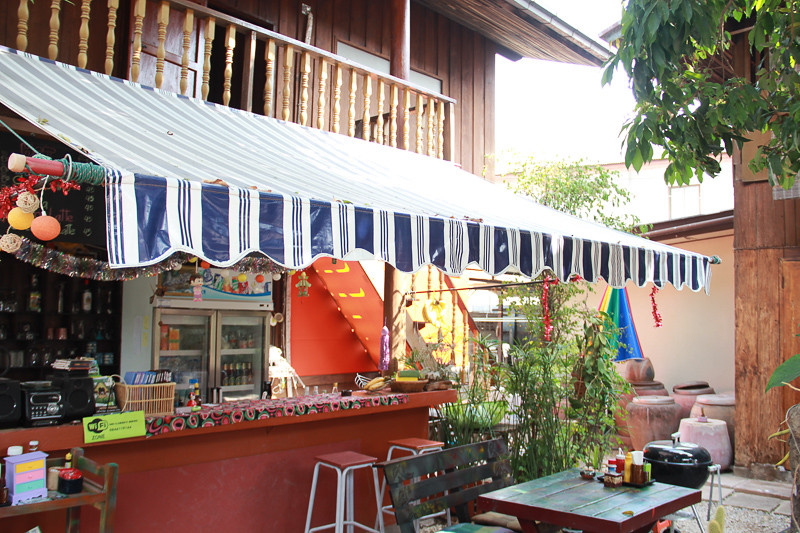

The tiled courtyard of the Vientiane Star Hotel, Laos
In Southeast Asia, many travelers choose to stay in guesthouses, a short-term housing solution somewhere between the shared rooms of a dorm-like hostel and the full-service expense of a hotel. Of course, all guest houses have their own vibe, some very nearly hotel-like and others much more personable, akin to booking a spot through Airbnb.
When I arrived in Chiang Mai, Thailand, the first place I stayed was Aoi’s Garden Home, a moderately sized guesthouse serving approximately two dozen travelers distributed between five small two-story buildings centered around a garden courtyard. The design is strikingly reminiscent of the tradtional Chinese courtyard home, or Siheyuan. This historic housing typology was once home to a family and its extended members, though today it is more common to see multiple immigrant families living within the courtyard structures that remain.

Chinese Courtyard Home, or Siheyuan, in Beijing, China 2011
In 2011, as a Landscape Architecture student at Cal Poly Pomona, I was fortunate to work on an award-winning multi-disciplinary project with architecture and urban planning students to study a culturally significant at-risk neighborhood composed primarily of this traditional housing format. Though the rigid Feng Shui and layered symbolism embedded within this typology is essential and engaging, it is also a spiritualized skin enshrouding an exceptionally functional housing strategy. This organization maximizes the value of site and climate conditions and fosters intimate social interaction. This holds true for Aoi’s Garden Home as well.

The Cafe at Aoi's Garden Home
Many design features are shared by Aoi’s Garden Home (AGH) and the Chinese courtyard home (CCH):

Fixin' to Leave Aoi's Garden Home, with some of Aoi's potted and planted garden in the background
This housing strategy essentially establishes a private pocket park right outside one’s door, with all the aspects that make this kind of open space inviting: easy access, comfortable human scale, intimate space, and copious shade. And the guesthouse seems to be an even stronger fit for this typology than a family home, as it establishes a safe and comfortable environment to strike up a conversation and meet new people, which can be incredibly valuable (and for many, desirable) while traveling. Seating can be organized close enough to engage strangers, but far enough to have personal space, one feels secluded from outside judgement or immensity of urban scale, and the structure creates a pleasant microclimate, seemingly regardless of the harshness of the weather beyond.
The courtyard strategy was also applied to apartment housing in mid-century Los Angeles, but with a decidedly Mediterranean influence (as most things in Southern California are…) and seemingly less of a symbolic or functional intent. Many of these structures have landscaping that relies heavily on lawn that is not intended for use or are merely pathways to get from streets and garages to apartments. Though this may be shifting. As people move back to and revitalize urban areas, there are opportunities to breathe social function into these underutilized and transitory spaces.

The courtyard at my father's old apartment (unfortunately the best shot I have)
A few years back, my father lived in a mid-size courtyard apartment complex, in downtown Long Beach, that had been recently renovated. Where once there was a pool now there was a large Trex deck with seating and a couple BBQ’s. The space was often occupied by a family or two and a few couples on any given night that I visited. It was an inexpensive, simple, and straightforward upgrade to a previously undervalued space which is now a catalyst for social activity within the complex. What other strategies are designers exploring to renovate these semi-public, latent spaces and is there potential for novel design strategies for new courtyard developments?
As part of our research project in China, we also looked at potential design strategies that leveraged various aspects of the Siheyuan at multiple scales to create housing strategies that accessed the highly functional and historically rich design of the Courtyard home to meet the demands of modern China. Here’s a quick look (admittedly out of context, feel free to ask questions in the comments):



Final thought: A host is also part of the equation of a successful courtyard complex. At AGH, Aoi is responsible for starting many conversations, and even friendships. She is kind but direct: “Matt, this is Tomaso. You talk to him.” She is the mayor of her own city. In the suburban neighborhood of my childhood there were a couple moms who more or less assumed this role. In many neighborhoods it seems people rise to this occasion or invent their own roll. In the neighborhood we studied in China, we also met a woman who played the roll of unofficial mayor… actually I think she had some kind of official title. Regardless, this is a pivotal role in any community, even temporary ones, like at a guesthouse, because it’s the common thread that weaves a community out of a group of wandering strangers. It is an important lesson to remember, because as designers, we are always searching for strategies to solve objectives by making something or cajoling people into participating through passive cues. Sometimes the solution is just a greeting and a handshake.
Living measures across the landscapes of Earth, rolling along the asphalt incision of world wilderness. Exploring the diversity of global urbanism from the ground. An intimately personal inquiry of lifestyle and limits, architecture and agriculture, organization and entropy, climate and cosmos. Point of embarcation: Los Angeles, California. First Destination: Chiang Mai, Thailand. Final Destination: Unknown. "I have no special talent, I am only passionately curious." _Einstein
No Comments
Block this user
Are you sure you want to block this user and hide all related comments throughout the site?
Archinect
This is your first comment on Archinect. Your comment will be visible once approved.